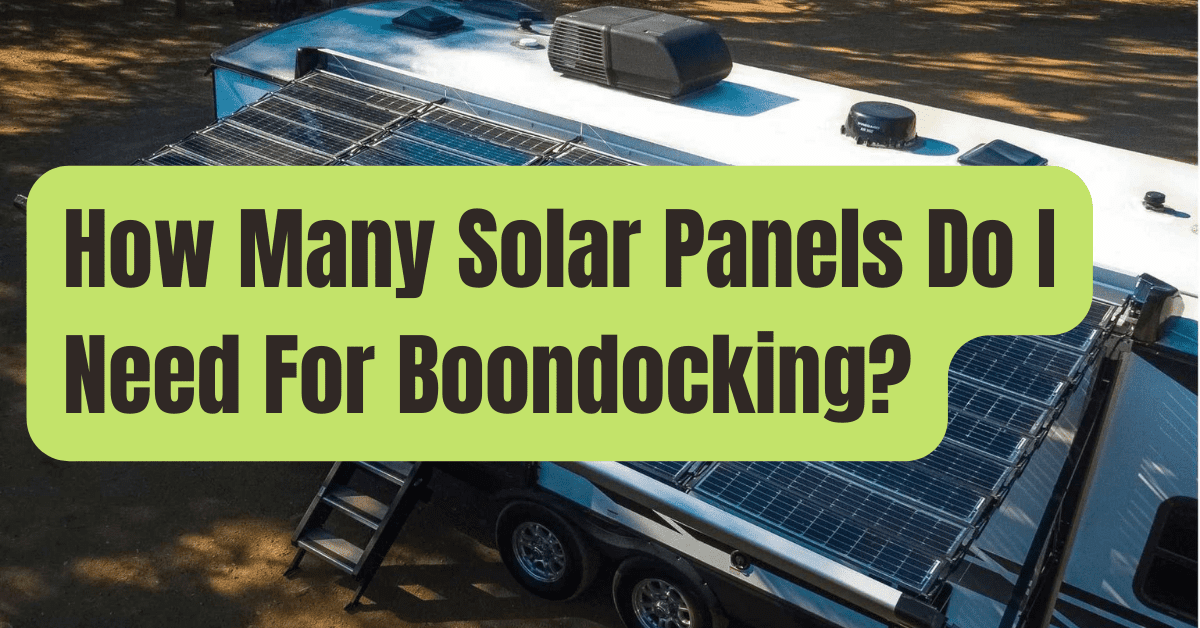Depending on how many batteries you need to maintain and what items you wish to power, the amount of solar panels required for RV boondocking may vary.
The entire amount of Amp Hours (AH) your batteries can store must be added to the power demands of your equipment.

For boondocking, how many solar panels do I need?
Regarding your batteries…
- A minimum of 300 watts of solar panels should be installed if you just have one 12 volt battery with a capacity of roughly 100 AH.
- You need have at least 400 watts of solar panels with two 12 volt batteries, or two 6 golf cart volt batteries, each with 200–250 AH.
- A minimum of 600 watts of solar panels should be installed if you have four 12 volt batteries or four 6 volt golf cart batteries with 400–600 AH.
These suggestions are based on the notion that a 100 watt solar panel can provide 30 AH of battery charge in 5 to 9 hours of light exposure.
Most RV solar panels vary in power from 150 to 200 watts on average.
Operating Your Equipment Day and Night
- You should be able to get by with 300 watts of solar panels and a single 12 volt battery if you only want to run the essential RV accessories during the day (LED lights, ceiling fans, power awning, water pump, refrigerator, furnace, water heater*, and power jack), as well as a few electronics plugged into your 120 volt wall sockets (television, laptop, and cellphones).
- Add a second 12 volt battery, or even better, upgrade them both to two 6 volt golf cart batteries, if you want to power your RV’s built-in furnace all night long. The same 300 watts of solar power could still be sufficient for you, but 400 watts should be plenty.
- Upgrade to two 6 volt golf cart batteries and purchase at least 400 watts of solar if you wish to add a 1,000 watt microwave oven to the aforementioned items.
- Adding a coffee machine, Instant Pot, toaster oven, blender, food processor, etc. Then update to either two 100 AH lithium batteries or four 6 volt golf cart batteries, and install at least 600 watts of solar power.
- Upgrade your solar panels to about 1,200 watts if you want to be able to use all of the above during cloudy weather.
Noting that the aforementioned suggestions are all minimums Bigger is usually better when it comes to solar and batteries.
However, they still include control panels and igniters that function on battery power.
These appliances often run on propane or 120 volt electricity.
Compared To Ground Panels, Roof-Mounted Panels
Roof-mounted solar panels cannot provide the claimed amount of electricity.
In reality, a 100 watt panel will only provide 50 to 75 watts.
This is due to the inability of roof-mounted panels to be adjusted at the proper 90 degree inclination to face the sun.
Additionally, because they are on the roof, many people neglect to clean them.
On the other hand, solar panels that are mounted to the ground may be angled at a 90-degree angle to the sun.
They often get the most wattage since they are also maintained cleaner more frequently.
Because they may be “set and forgotten,” roof-mounted solar panels are popular.
In the meantime, you must physically install ground panels in the sun’s path and connect them to your solar charge controller.
Throughout the day, you may need to tilt and rotate the panels.
Additionally, ground panels face the danger of being stolen and might topple over in heavy wind gusts.
Can I Run the Air Conditioner on Solar Power?
Yes, technically.
To power a single AC unit for around four hours, you’ll need a larger battery bank with a storage capacity of at least 600 AH.
To charge the batteries fast and effectively enough to bring them up to charge and keep you powered through the evening, you’ll also need at least 1,200 watts of solar panels.
However, it is still unfeasible to run a 15,000 BTU air conditioner from a battery due to how many watts it uses.
For the majority of RV boondockers, running a single AC unit still requires a generator with at least 3,600 watts of power.










